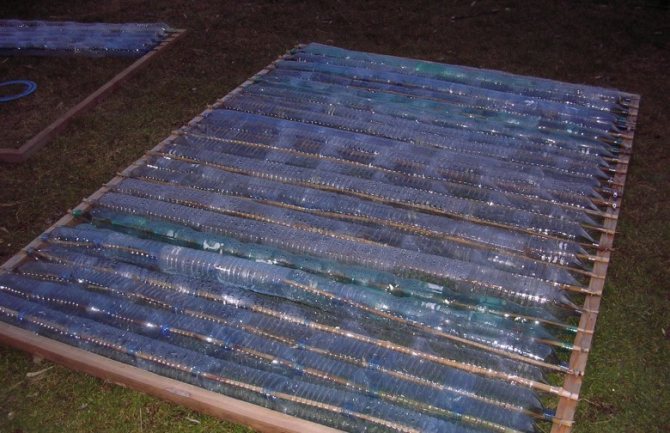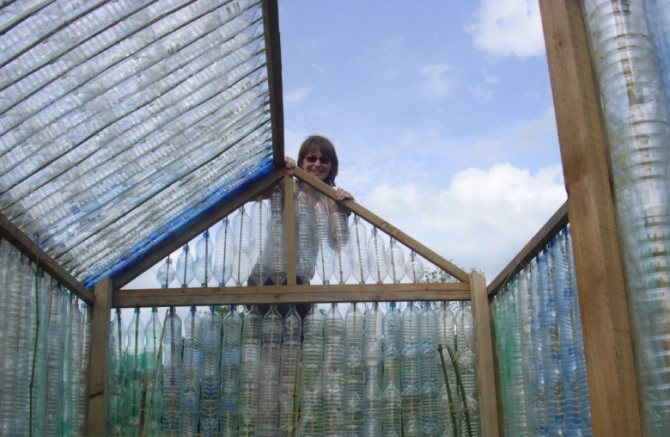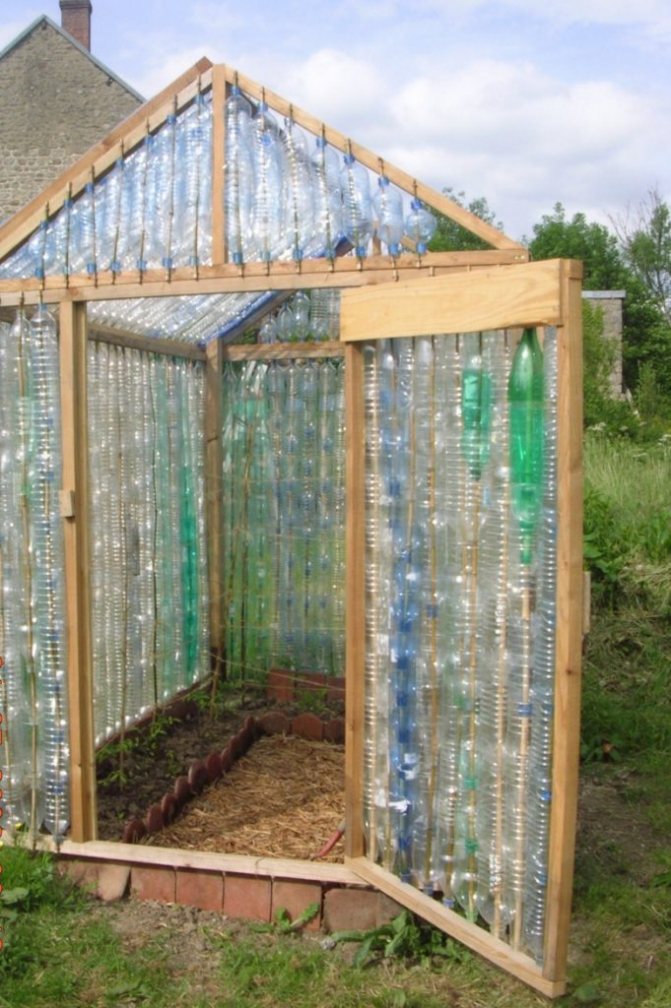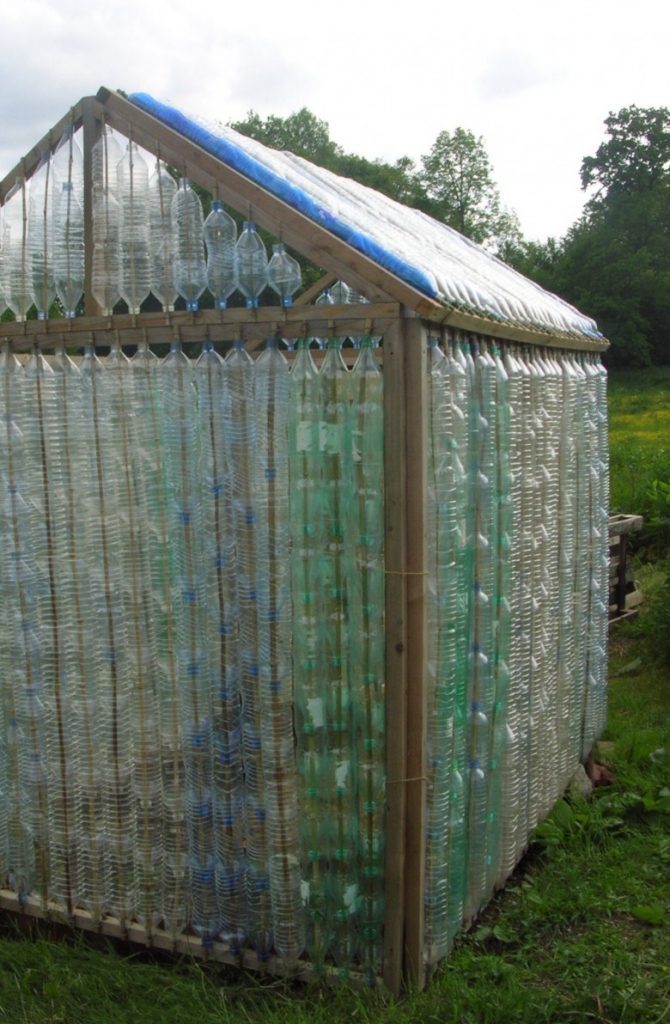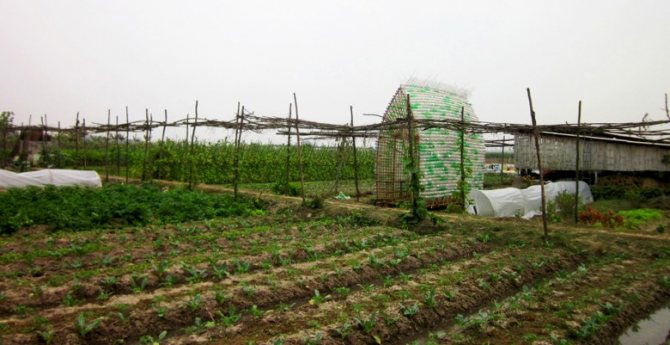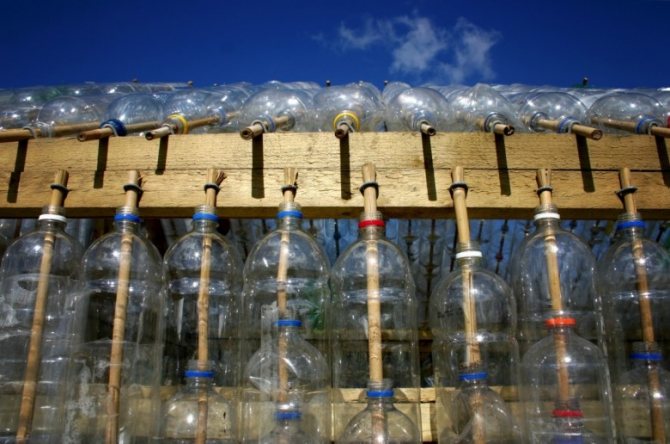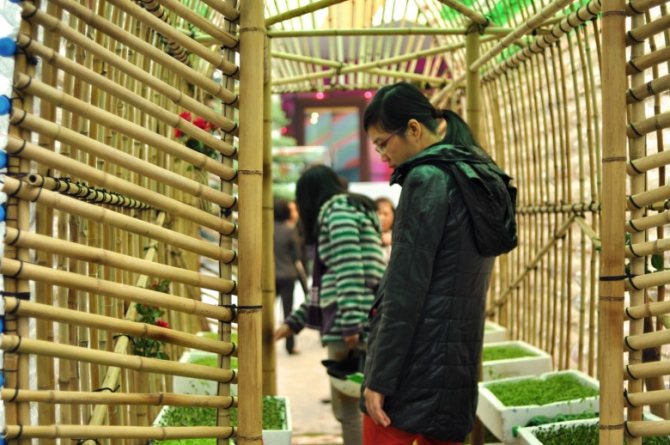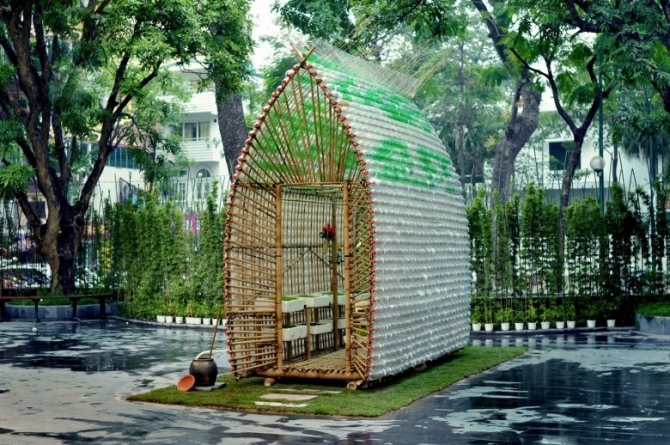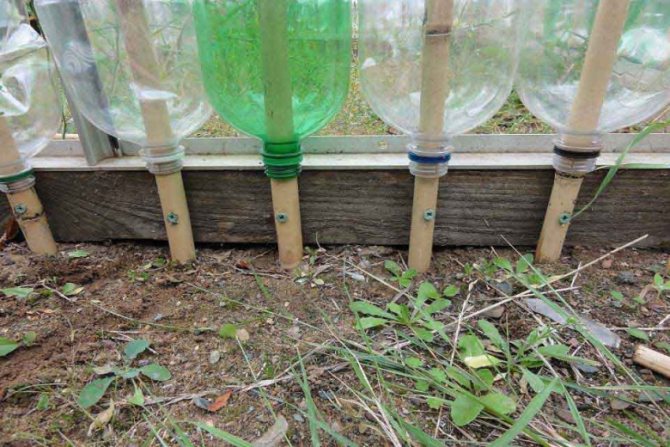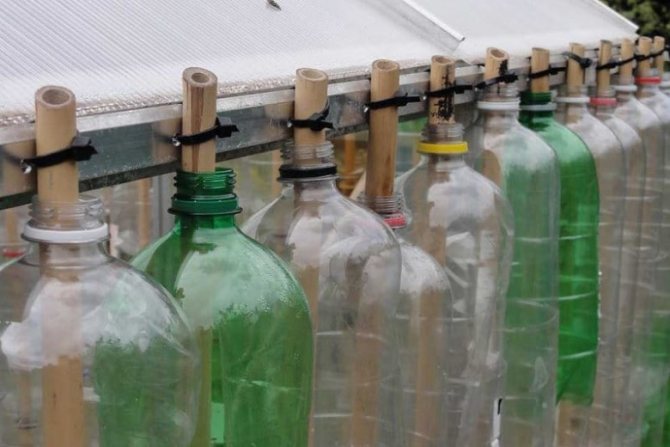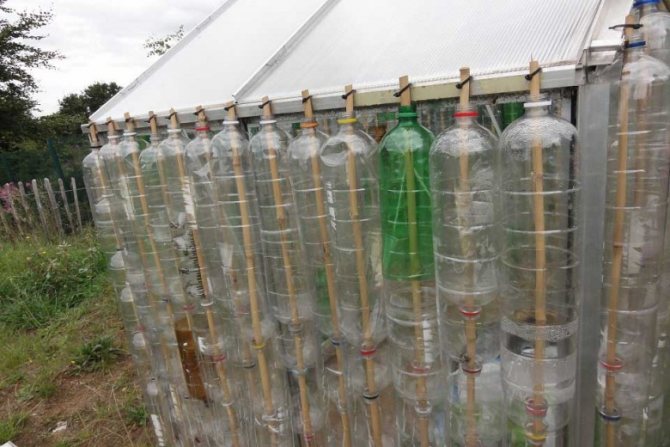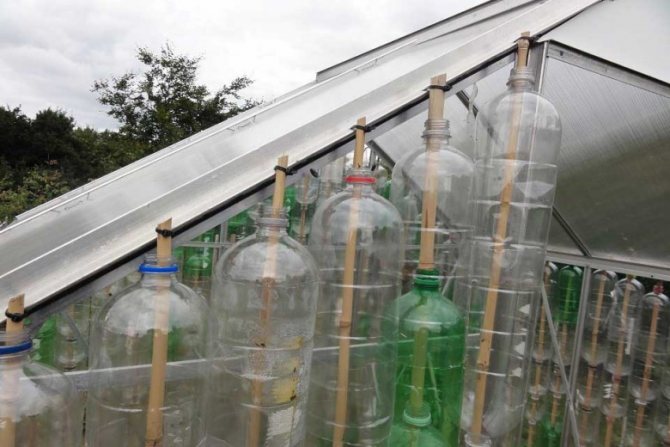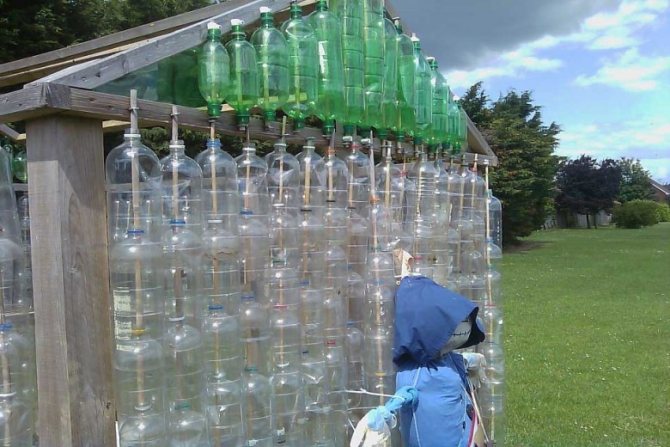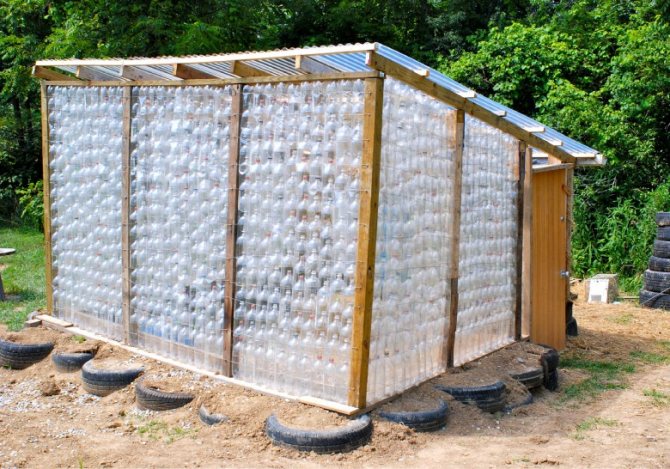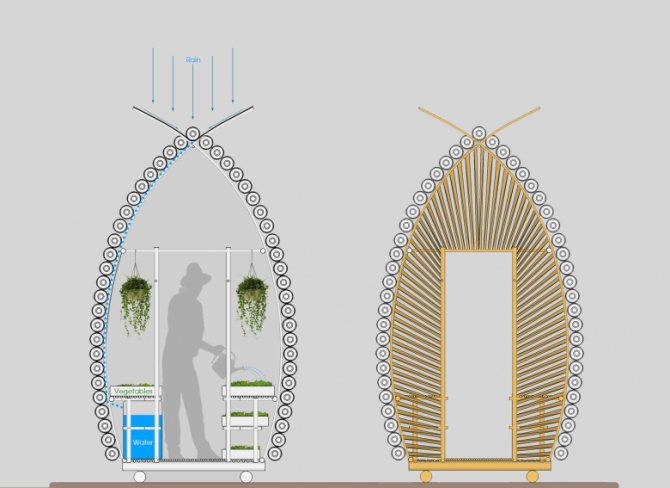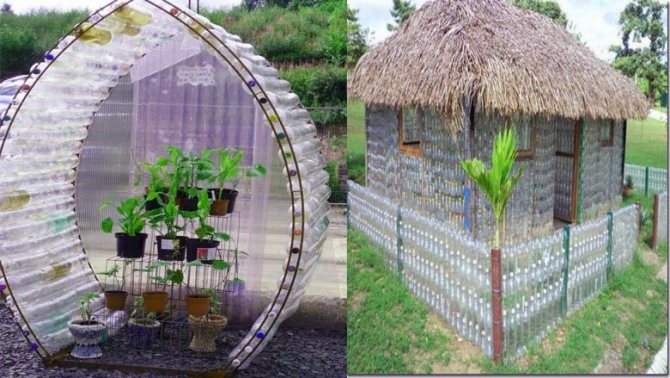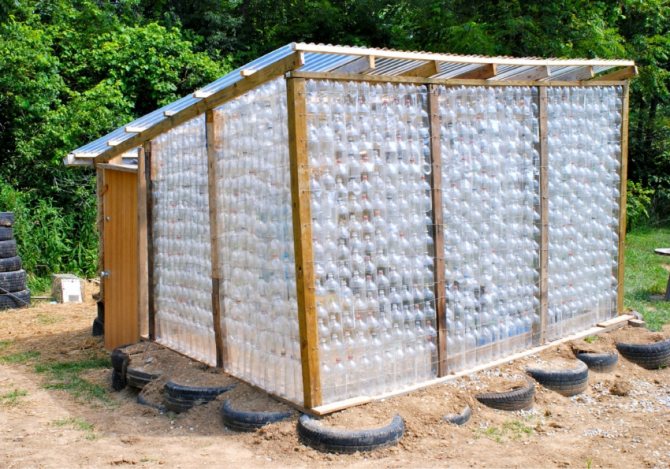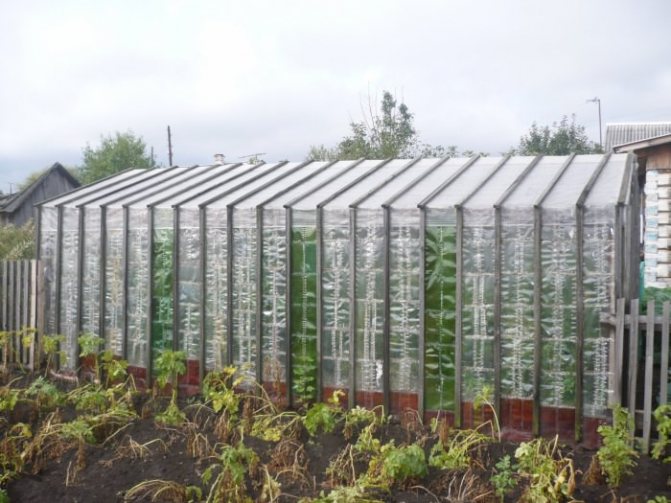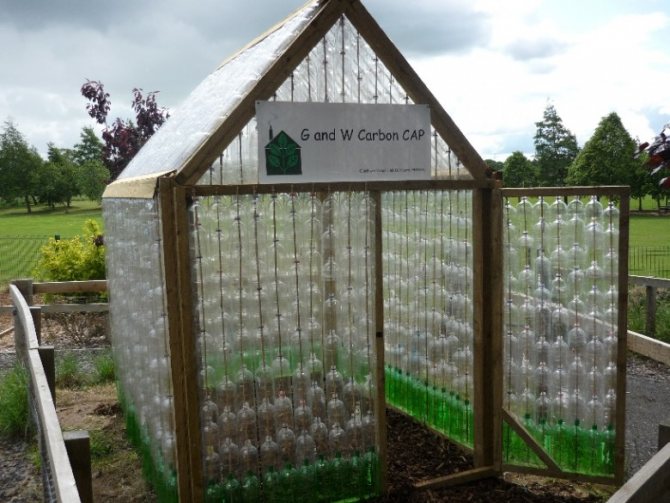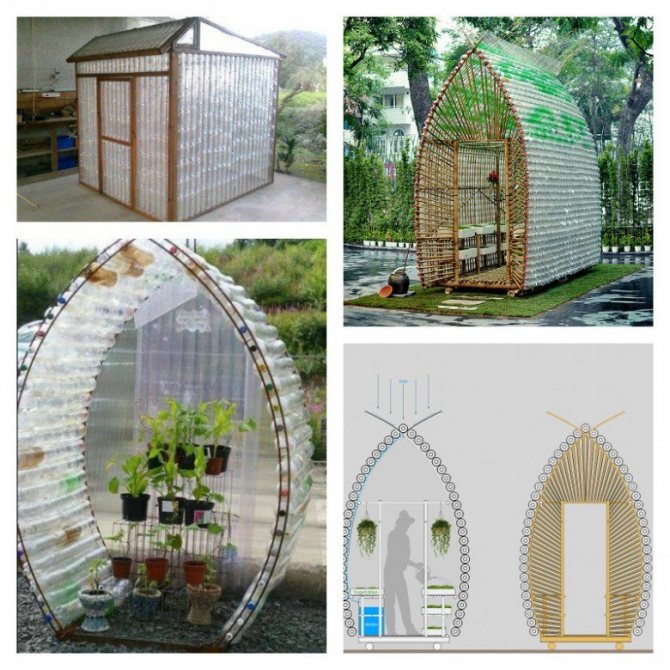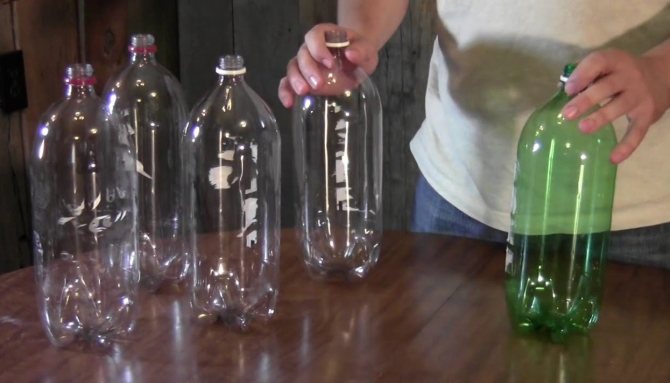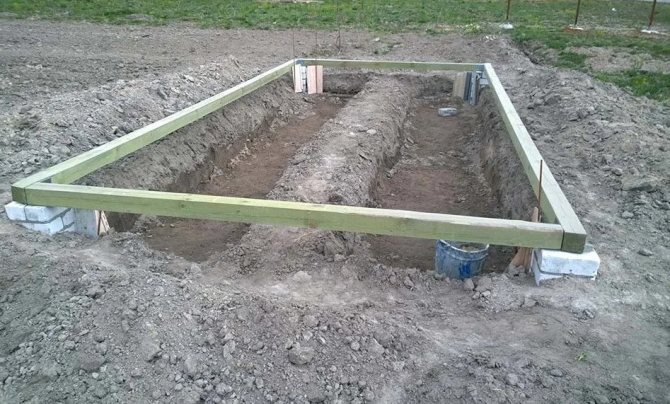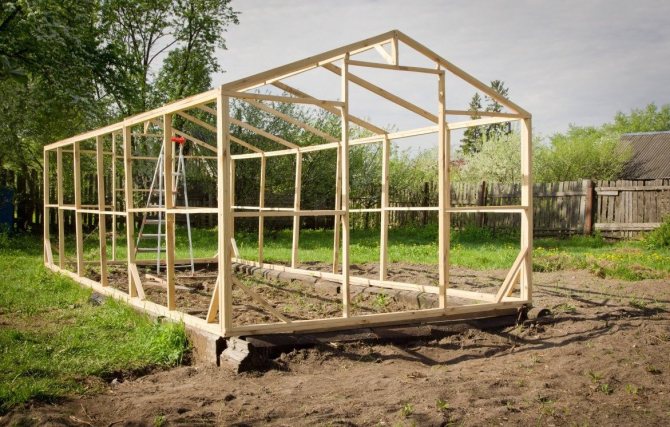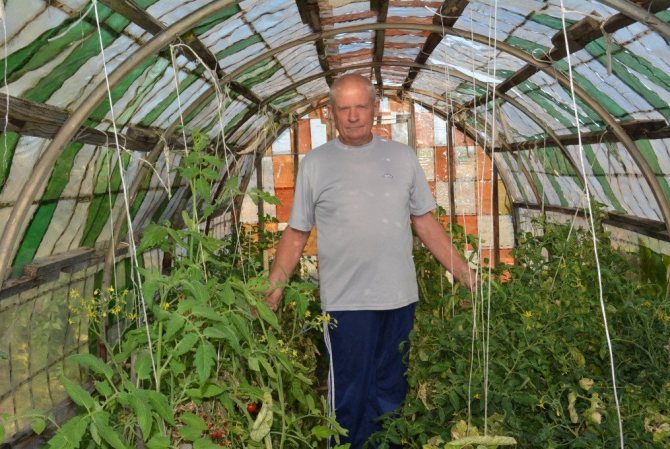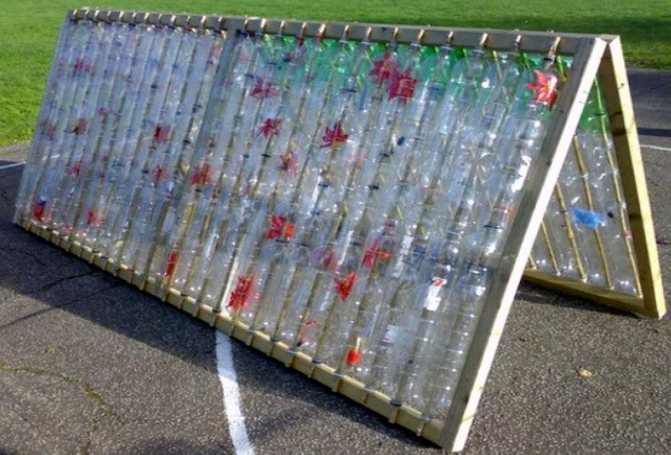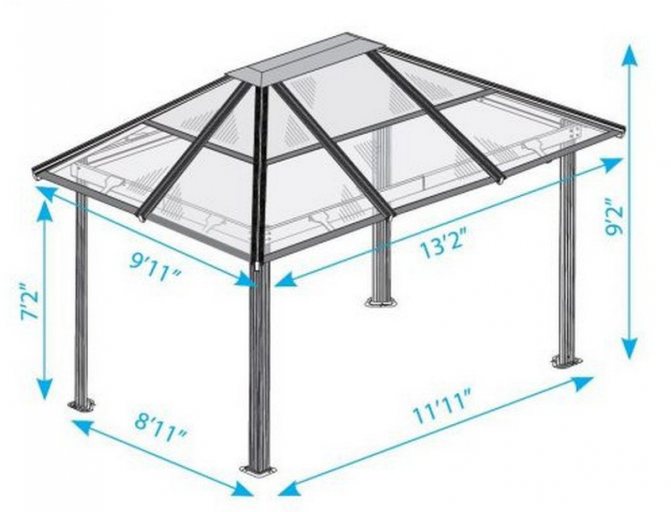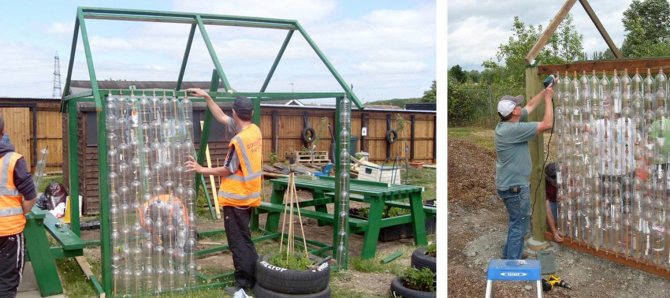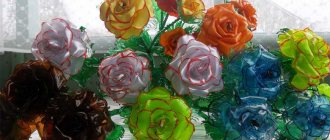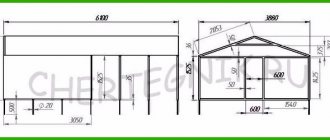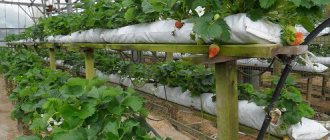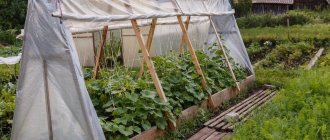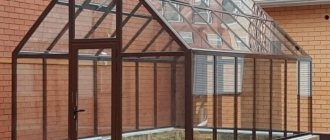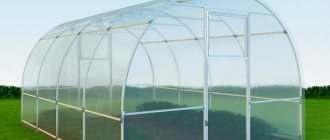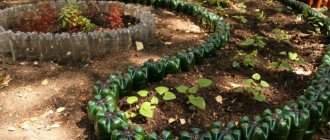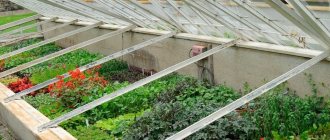Making a greenhouse out of plastic bottles is quite realistic, original and economical. First of all, it is possible to usefully use unnecessary used containers for the construction of a universal structure for seedlings.
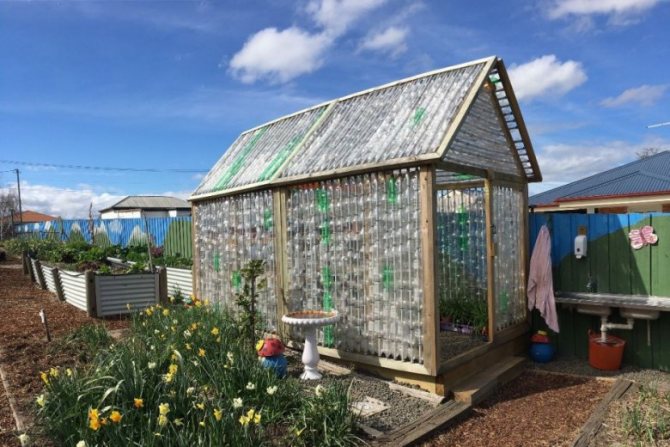
But the main thing is that such a greenhouse will not require large cash costs and will certainly attract the surprised looks of guests and just passers-by.
A strange choice? Not at all
Plastic bottles are made from polyethylene terephthalate (PET). It is completely neutral and suitable for drinking liquids.
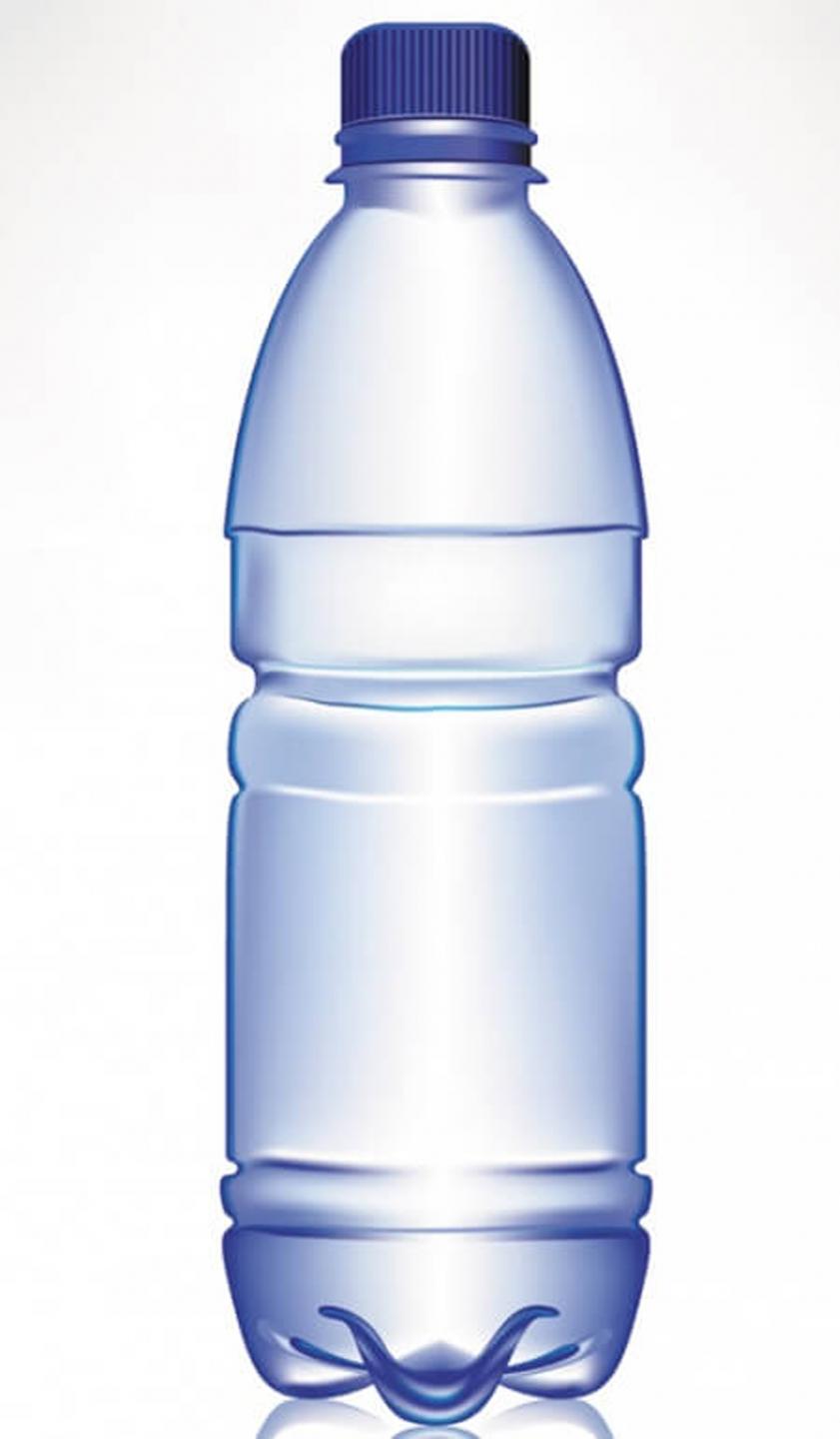

A PET bottle is such a multifunctional thing
Plastic bottles are an inexhaustible storehouse for various crafts; single bottles are used as flower pots and tiny seedlings. From a large number of them, drainpipes are made. And sometimes - a serious engineering structure: deep drainage at the site. Our "Kulibins" went further and came up with a new application for bottles: fences and greenhouses. Moreover, everyone has a lot of empty bottles, and you can always ask your friends and neighbors to throw more.
Applications for plastic bottles
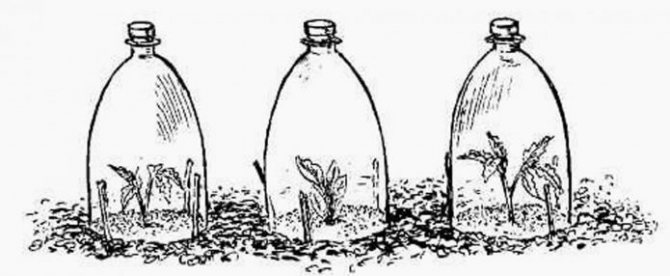

Mini greenhouses from plastic bottles
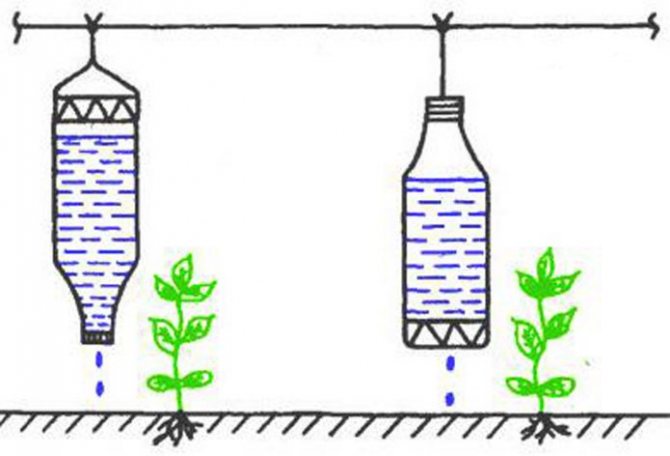

Drip irrigation with plastic bottles
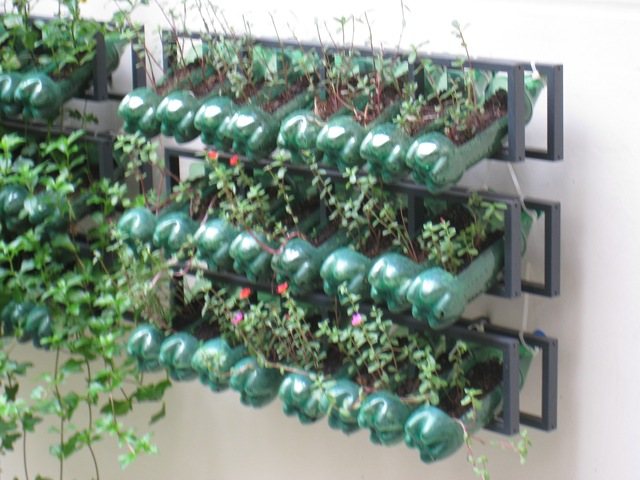

Growing flowers with plastic bottles
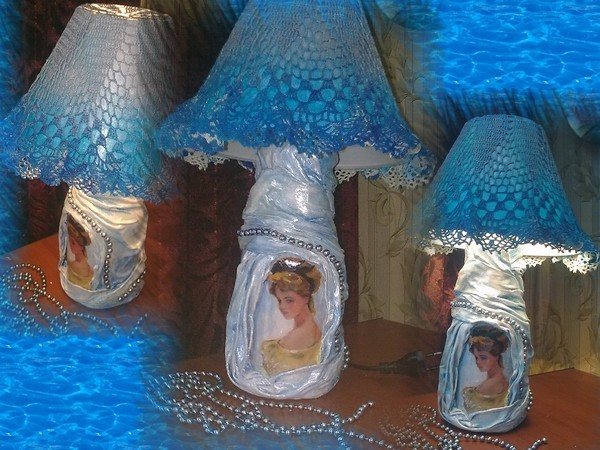

Crafts from bottles - table lamps
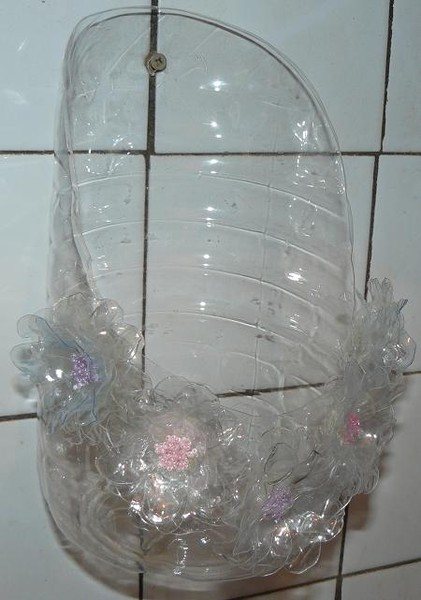

Planter from a bottle and multiple bottle bases
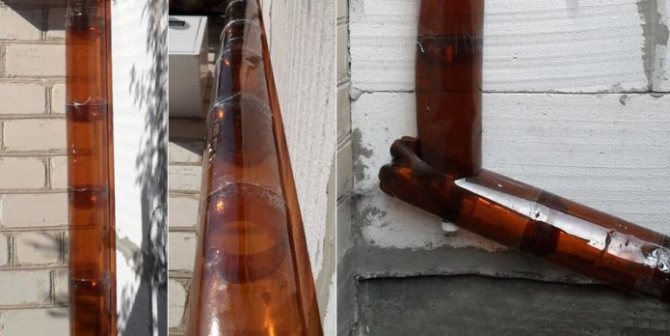

Downpipes from bottles
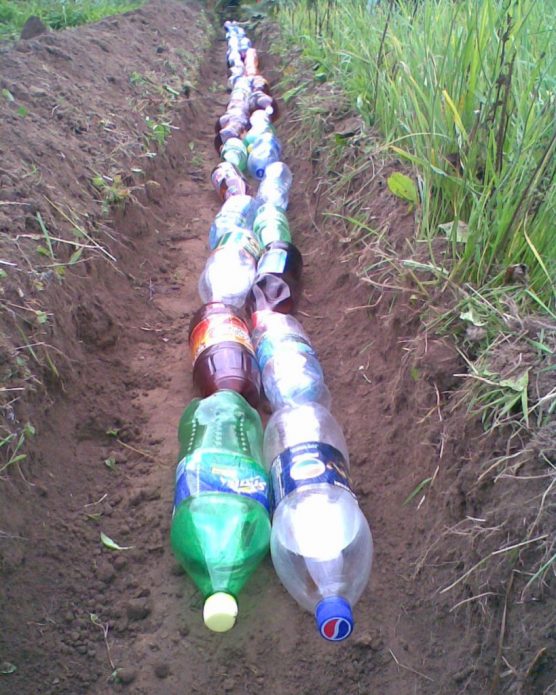

The trench with bottles is prepared for filling with drainage material - there will be deep drainage of the site
The bottle greenhouse is durable, strong, easy to assemble, maintenance-free, incredibly cheap and easy to replace. And most importantly, it is much warmer than its “competitors”. Because everyone knows from the school physics course: air is the best heat insulator, and bottles create the effect of a thermos.
There is simply no such greenhouse warmer. Experienced gardeners assure: for early sowing and growing seedlings even in cold weather, there is even no need to additionally warm the greenhouse from the inside from bottles.
Now let's decide: what should we call the future structure.
Testimonials
Spiridonov Andrey Viktorovich, 44 years old
For two years I collected empty plastic bottles, tried to choose light and the same size. Five years ago he built the first greenhouse, using only solid containers. In the first year, I had a frame made of boards and bars, it stood for 3 seasons, then the tree began to rot. I built the second greenhouse from fittings, painted it, sheathed it with sewn plastic sheets. This greenhouse is already in its fourth year. In the spring I do minor repairs to the plates, and that's it, no more problems.
Ivanova Svetlana Igorevna, 32 years old
I heard about such greenhouses, they say a lot of different things on the forums. I think that it is profitable, but I doubt the harmlessness of plastic bottles, this material is toxic, many harmful substances are released during combustion. The plastic will heat up in the sun, isn't it dangerous for the environment and human health? My husband and I have already begun to collect containers, but we still cannot dare to build a greenhouse out of them.
Smirnova Elizaveta Sergeevna, 37 years old
Our plastic greenhouse has been in operation for 3 years. In the spring we are going to make such a covering on the arcs. In general, I am satisfied with the greenhouse, the costs of its construction are minimal, it performs its functions perfectly. Compared to conventional film, this material is more durable.We use the old film for additional shelter in case of strong winds or sudden cold snap.
Greenhouse or greenhouse?
Both in everyday life and in the press, there is still confusion, they are too similar in design and tasks. Both here and there - a base of frames and a coating that transmits ultraviolet light and does not transmit cold.
Greenhouse - protection for semicircular beds, often a very long structure, and always low. Made from metal and plastic pipes or wooden slats. But often equal lengths of plastic pipes or metal fittings are simply stuck into the ground. The greenhouse is covered, as a rule, with a light film, which simply folds back in warm weather or to care for plants.
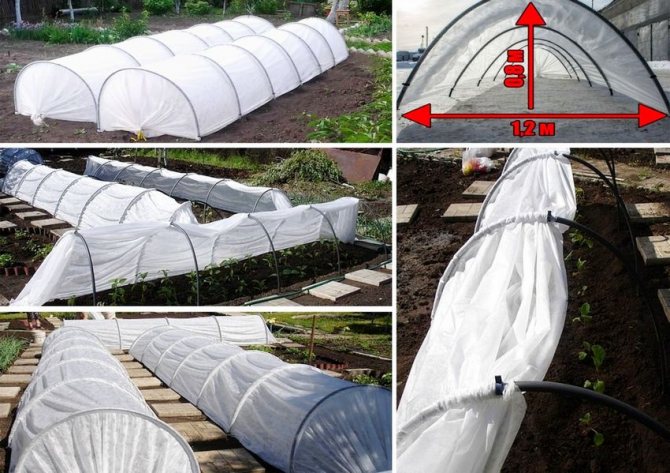

Greenhouses made of arcs and foil over the beds
A greenhouse is a more capital and taller structure. You can go there at full height. The frame of greenhouses is made of wood, metal pipes, metal corners, plastic pipes of various composition and quality, and, finally, the whole greenhouse can be made of ready-made aluminum double-glazed windows of the window type. To protect it from rain and snow, cold and wind, the frame is covered with a plastic sleeve reinforced with a polyethylene film, bubble wrap, non-woven materials, cellular polycarbonate and even glass.
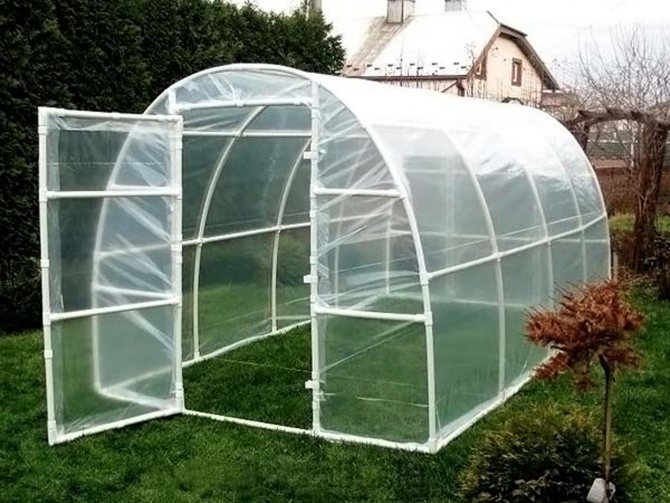

Greenhouse made of plastic pipes and foil
Having weighed everything, we will still call our building a "greenhouse", despite the capital frame.
For which plants is it suitable?
Seedlings of cabbage, tomato, eggplant and cucumber are grown in plastic greenhouses. If cabbage and tomatoes are planted in open ground in June, then cucumbers, zucchini and squash will continue to harvest in a greenhouse until September. These actions will provide the greenhouse with additional protection against overcooling:
- Installation of arches over the beds by pulling the film;
- Arrangement of warm beds with bio-heating.
REFERENCE: Greenhouses are suitable for annual seedlings of currants, raspberries, blackberries. They are used for transplanting young bushes of strawberries, wild strawberries for the winter period, with additional shelter from spruce branches.
Plastic bottles as a material: advantages and disadvantages
Benefits:
- durability: it is clear that plastic bottles do not wear out, fungus does not start on them, and in case of a defect, it is enough just to replace a bottle or two;
- availability: a greenhouse made of plastic bottles is cheaper than all others possible in terms of material;
- lightness and simplicity of making a greenhouse from bottles: for this you do not need to be a super-ace in construction;
- the ability to make any greenhouse design out of bottles: a house, a lean-to, an arched, and so on;
- ease of installing a greenhouse anywhere in the garden and transferring it to this place without analysis into its components;
- versatility: a greenhouse made of bottles is suitable for a variety of tasks, from growing seedlings to keeping heat-loving plants in the cold season;
- temperature stability (bottles withstand decent temperature drops from -50 to + 130 ° C and do not heat up);
- environmental friendliness: the material of the bottles is chemically neutral and harmless to humans, land and plants;
- beauty: you can choose the color of the bottles so that the greenhouse becomes a real work of art.
There are only two disadvantages:
- it is rather difficult to collect the required number (at least 300–400) of bottles per greenhouse;
- it is quite difficult to find the time to painstakingly assemble a greenhouse from bottles.
What can be used for the frame
For frame almost any material is suitable. You can choose from metal, wood or plastic.
Metallic profile will stand for many years. The metal will provide strength and durability to the greenhouse. All that is required is only to paint it from time to time, and to wash it from infection at the end of the season. But to build such frame some skills of working with metal, special tools are required. The most convenient metal carcass cook.
Wood how the material impresses with its availability and cheapness. It is quite lightweight and comfortable to work with. With proper design, the frame will also turn out to be strong enough to withstand wind and snow loads.
Everyone
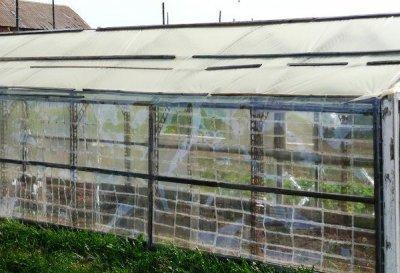

year the wooden base will have to be processed special antiseptics.
The service life of such a frame will be comparable to that of a bottle cover. Most likely, you will have to change the coating and frame at the same time.
An alternative to the traditional material is the frame made of PVC pipes... They are very light and allow you to make a greenhouse of any shape: not only one- or two-slope, but also an arched one. Perhaps such a frame will require more careful strengthening in order to withstand any bad weather.
If you have old windows lying around in your country house, then window frames can be used as material for greenhouses.
Preparation for construction in general
First of all, we need to understand what size the greenhouse we need. Given the complexity of collecting the ingredients, you don't need to make it too big.
Let our structure be on a wooden base, in the form of the most primitive small house. We accept the dimensions of the base 2x3 meters, the height of the walls of the greenhouse is 2 meters, the height of the ridge is 1 meter.
We draw a drawing by hand, set the dimensions and estimate how many timber, slats, screws and corners we need to purchase.
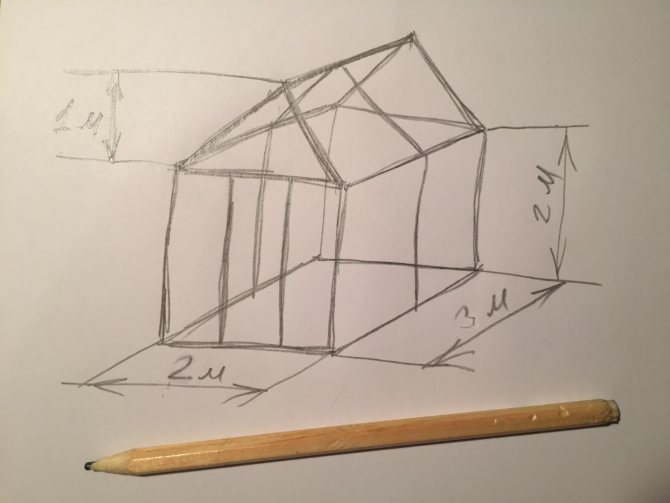

Hastily sketched greenhouse drawing
For the frame, we need a thin pine bar 40x40x6000 mm.
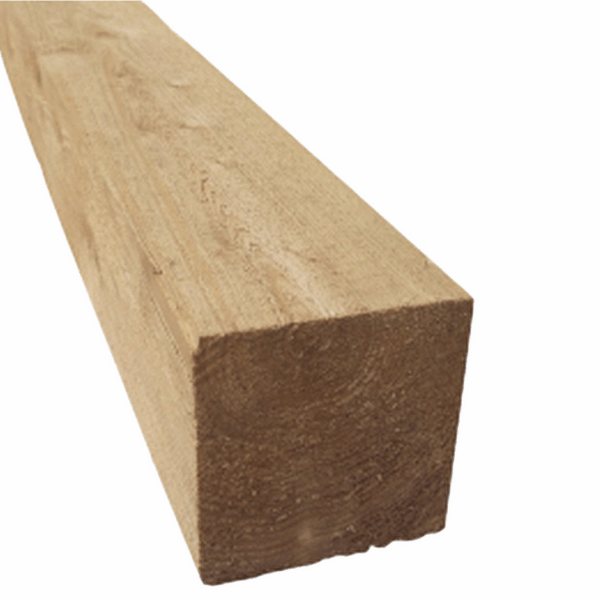

Edged pine bar 40x40x6000 mm - the basis of the structure
For its connection into the structure - metal corners.
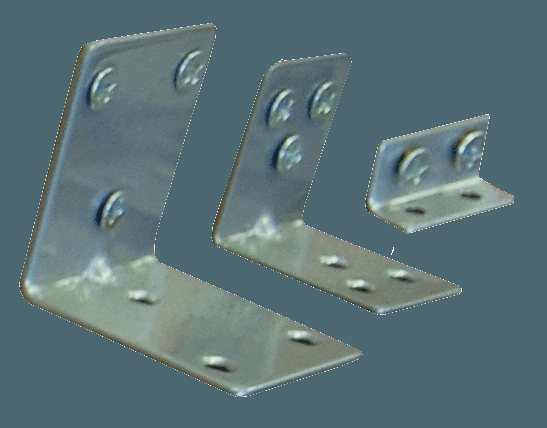

The corners are needed to strengthen the joints
For connecting bottles into pipes - thin wooden slats 20x20x3000 mm.
Pine lath 20x20x3000 mm
To fix the parallelism of the walls - a skein of three thick fishing lines.
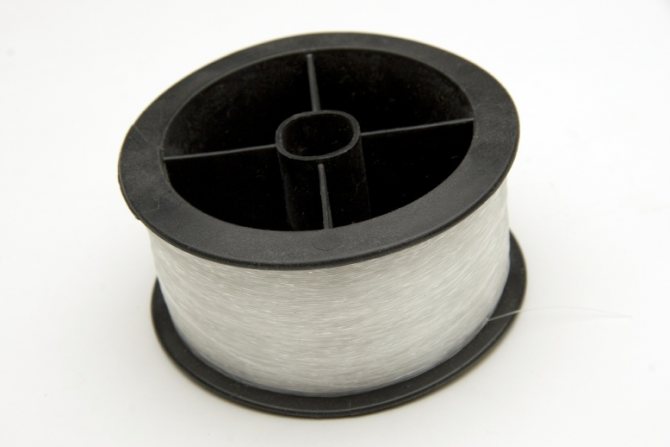

Fishing line is needed to fix the walls
To cover the roof - a piece of tubular film.
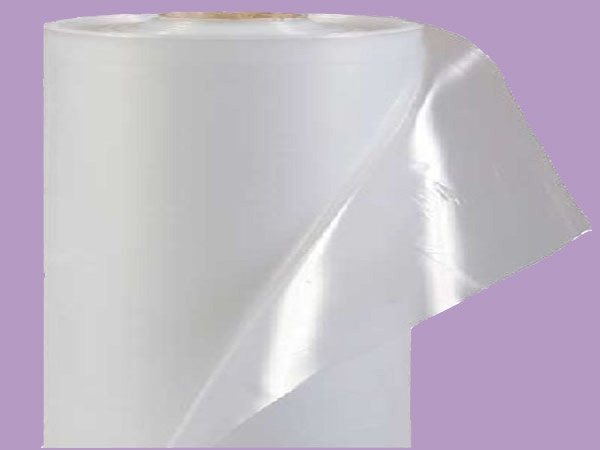

Sleeve film is not needed in a roll, but in meters
When we calculate the necessary amount of materials, we will be pleasantly surprised by the cheapness of our project. It's funny, but the most expensive is not even a timber, but a rail needed to be threaded into bottle “pipes” to create stiffening ribs. in fact, you can do without rails, or thread a wire or wire into the "pipes". And the bottles will not cost anything at all - except for the labor of collecting a sufficient number of them.
Preparing bottles
- You need to collect about four hundred two-liter bottles. White plastic (water bottles) transmits ultraviolet light better. And to decorate the structure, you can pick up a number of bottles of a different color: blue (from carbonated water), green (bottles for drinks) and brown (bottles for beer). in fact, bottles come in all colors of the rainbow. But only these four are produced in large quantities (to be able to collect the required amount).
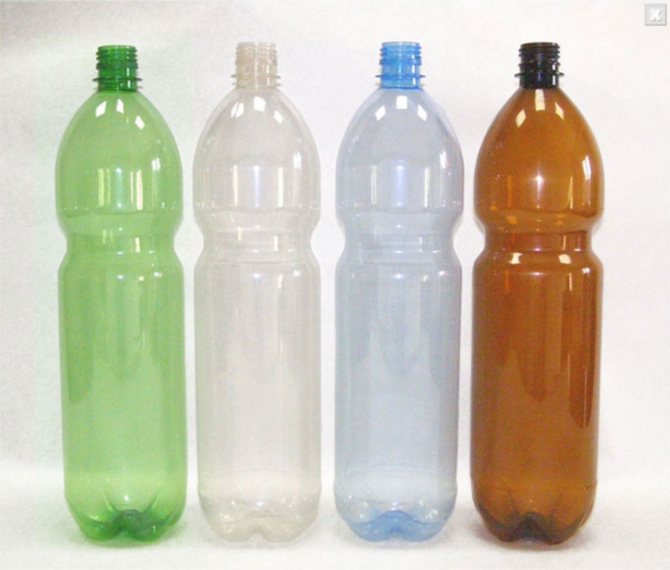

The four most common bottle colorsWith some diligence, you can create beautiful ornamented greenhouse walls from them.
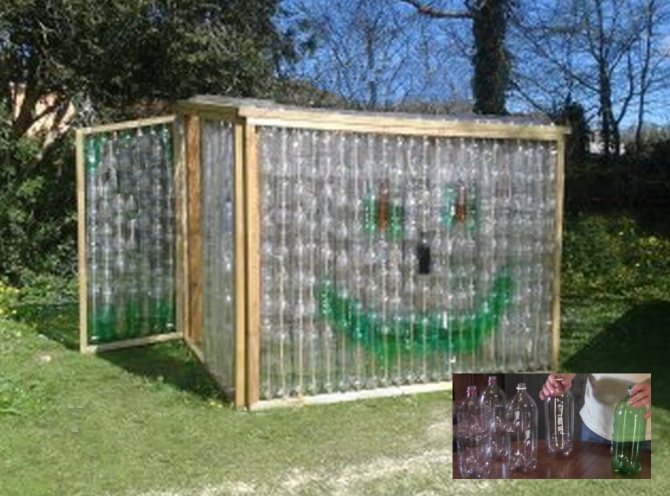

Greenhouse with a smile, creativity is immediately visible - The bottles must be removed from the stickers in advance. Better to use bottles with regular paper labels that you can simply soak off.
Required tools
- Bayonet shovel
- Shovel shovel.
- Electric saw (hacksaw).
- Hydro level.
- Carpenter's corner.
- Drill (with a set of drills).
- A hammer.
- Awl.
- Shoe knife.
- Roulette.
- Screwdriver.
- The stapler is assembly.
Calculation of the required materials - table
| Position | Name | Specification | number | Unit price | Price | Notes (edit) |
| 1 | Pine edged beam | 40x40x6000 mm | 6 items | Rub 95 / pc | 570 rubles | |
| 2 | Galvanized equilateral bracket | 40x40x60x2.0mm | 25 pieces | Rub 35 / pc | 875 rubles | |
| 3 | Sliced pine lath | 20x20x3000 mm | 50 pieces | Rub 35 / pc | 1750 rubles | |
| 4 | PET bottles (plastic) | capacity 2 liters | 400 pieces | |||
| 5 | Calibrated fishing line 1.00 mm | 1.00 mm x50 m | 3 skeins | 90 rubles | 270 rubles | |
| 6 | Polyethylene film 80μm | width 3m / sleeve 1.5m | 4 meters | 20 rub / m | 80 rubles | |
| 7 | Antiseptic impregnation (and optionally paint) | As needed, but a small amount | ||||
| 8 | Transparent wide technical adhesive tape | 75 mm x 50 m | 3 skeins | 49 rub / skein | 147 rubles | |
| 9 | Self-tapping screws | About 2 kg | On demand | |||
| Total | 4412 rubles (excluding the cost of screws, impregnation and paint) | |||||
Secrets of building construction
- It is worth collecting material for a greenhouse in advance, perhaps from the very end of summer, in order to collect the right amount for next spring.
- You can always buy bottles or ask the neighbors of summer residents who do not need them.
- You can cut the material in different ways - using a mounting knife, a cutter, or just large scissors.
- You can fasten the material together with a thread, fishing line, wire, or you can glue it down, slightly melting the edges on fire.
- For construction and convenient operation, the right solution would be to collect identical bottles. Containers of 1.5 liters are most suitable for a comfortable construction site.
- If you are worried about the strength of the walls and their stability, there are many ways to ensure these qualities - to pull the nylon threads on both sides of the greenhouse more often, install a thin crate, but every two or three bottles, install a metal mesh on both sides, the thinnest, just in tightness.
- If you find it inconvenient to build a roof in this way, you can always just stretch an inexpensive film. The main thing is that it will last for one year, and in the next you can always buy a new one, because it will cost a penny.
- The doors to the greenhouse can also be made of bottles, but in order not to torment yourself, a frame door made of wood covered with film will be enough.
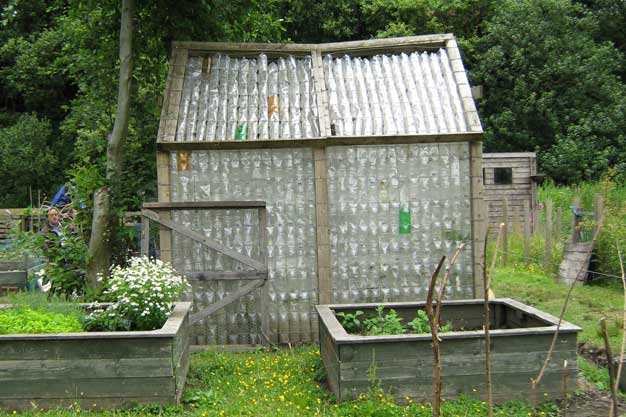

From bottle plates
This method is more complex and requires more impact, but the result is worth the effort. The greenhouse is not inferior in terms of reliability and structure to wooden and metal buildings, and the appearance resembles a glass greenhouse.
- First, the bottle must be cut at both ends, removing the neck and bottom. The resulting part should have a rectangular elongated shape.
- In order for the plastic to stop curling, the sheets must be carefully smoothed out with an iron, using thick paper.
- Aligned workpieces should be 17x32 cm in size, after which they can be sewn with metal wire.
- The plastic sheets need to be stacked on top of each other so that there is no space between them.
- Finished plates must be fixed with nails on the frame.
Drafting and tools
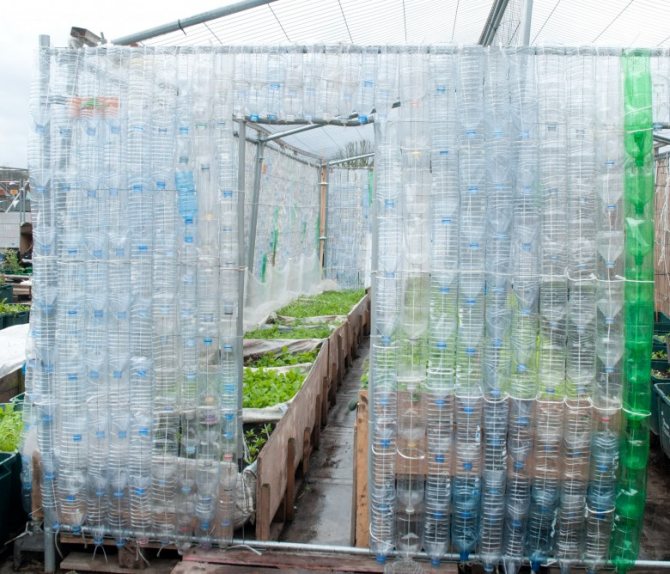

There is no need to waste time on complex calculations when drawing up such a project. It is enough to draw a simple drawing indicating the length, width and height of the future building. When planning the frame in the drawing, indicate the frequency with which the bearing elements will be located. They also indicate the shape of the roof and the dimensions of the doors. To work you need simple tools:
- big awl;
- a cutter for wood or metal;
- nails and hammer;
- nylon thread;
- construction tape;
- laser level;
- drawing paper and pencil.
The area is cleared of debris and leveled. The best location for a greenhouse is southeast or southwest. This will contribute to good lighting and protection from drafts. Also, before starting construction, mark the territory so that there are no errors in the process.

